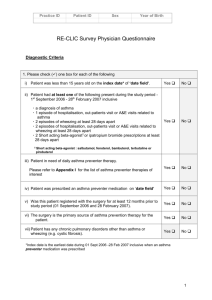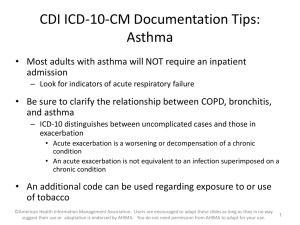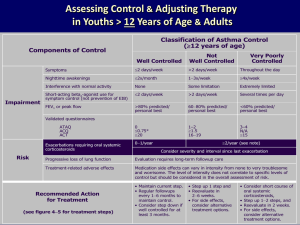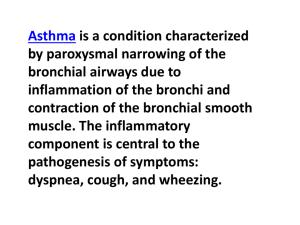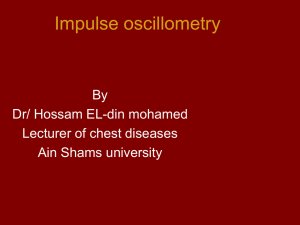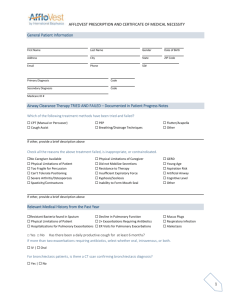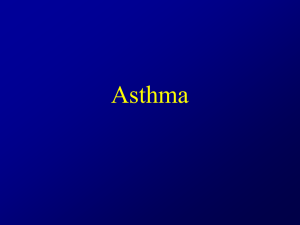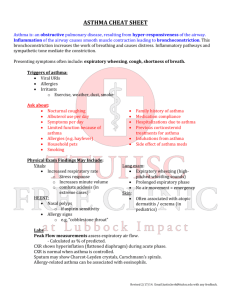Asthma Mega 4-12
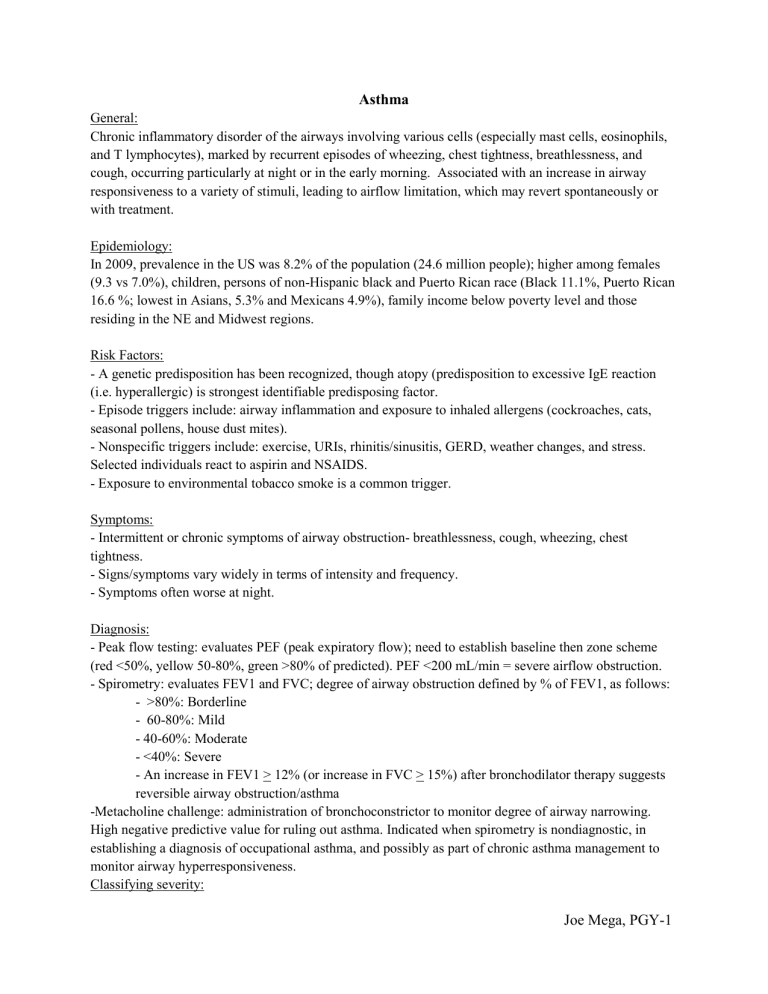
Asthma
General:
Chronic inflammatory disorder of the airways involving various cells (especially mast cells, eosinophils, and T lymphocytes), marked by recurrent episodes of wheezing, chest tightness, breathlessness, and cough, occurring particularly at night or in the early morning. Associated with an increase in airway responsiveness to a variety of stimuli, leading to airflow limitation, which may revert spontaneously or with treatment.
Epidemiology:
In 2009, prevalence in the US was 8.2% of the population (24.6 million people); higher among females
(9.3 vs 7.0%), children, persons of non-Hispanic black and Puerto Rican race (Black 11.1%, Puerto Rican
16.6 %; lowest in Asians, 5.3% and Mexicans 4.9%), family income below poverty level and those residing in the NE and Midwest regions.
Risk Factors:
- A genetic predisposition has been recognized, though atopy (predisposition to excessive IgE reaction
(i.e. hyperallergic) is strongest identifiable predisposing factor.
- Episode triggers include: airway inflammation and exposure to inhaled allergens (cockroaches, cats, seasonal pollens, house dust mites).
- Nonspecific triggers include: exercise, URIs, rhinitis/sinusitis, GERD, weather changes, and stress.
Selected individuals react to aspirin and NSAIDS.
- Exposure to environmental tobacco smoke is a common trigger.
Symptoms:
- Intermittent or chronic symptoms of airway obstruction- breathlessness, cough, wheezing, chest tightness.
- Signs/symptoms vary widely in terms of intensity and frequency.
- Symptoms often worse at night.
Diagnosis:
- Peak flow testing: evaluates PEF (peak expiratory flow); need to establish baseline then zone scheme
(red <50%, yellow 50-80%, green >80% of predicted). PEF <200 mL/min = severe airflow obstruction.
- Spirometry: evaluates FEV1 and FVC; degree of airway obstruction defined by % of FEV1, as follows:
- >80%: Borderline
- 60-80%: Mild
- 40-60%: Moderate
- <40%: Severe
- An increase in FEV1 > 12% (or increase in FVC > 15%) after bronchodilator therapy suggests reversible airway obstruction/asthma
-Metacholine challenge: administration of bronchoconstrictor to monitor degree of airway narrowing.
High negative predictive value for ruling out asthma. Indicated when spirometry is nondiagnostic, in establishing a diagnosis of occupational asthma, and possibly as part of chronic asthma management to monitor airway hyperresponsiveness.
Classifying severity:
Joe Mega, PGY-1
Mild Intermittent: Sxs < twice/week; normal PEF between exacerbations; nocturnal sxs < twice/month;
FEV1 or PEF >80%; 0-1 exacerbations/year requiring systemic glucocorticoids
Mild Persistent: Sxs > twice/week, < once/day; nocturnal sxs > twice/month; FEV1 or PEF >80%; >2 exacerbations/year requiring systemic glucocorticoids
Moderate persistent: Daily Sxs; daily use of rescue inhaler; nocturnal Sxs >twice/week; FEV1 or PEF
>60%, but <80%; >2 exacerbations/year requiring systemic glucocorticoids
Severe persistent: continual sxs; limited physical activity; frequent exacerbations; frequent nocturnal sxs;
FEV1 or PEF < 60%; >2 exacerbations/year requiring systemic glucocorticoids
Treatment:
- Identification and avoidance of asthma triggers
- Chronic Pharmacologic Treatment:
- Mild Intermittent : Inhaled short-acting beta
2
-agonist (SABA), e.g. Albuterol (ProAir, Ventolin,
Proventil) and levalbuterol (Xopenex); Mast cell-stabilizing agents may be considered prior to exercise, e.g., cromolyn (Intal).
- Mild Persistent: Daily long term controller- low dose inhaled corticosteroid (ICS), e.g. budesonide (Pulmicort) 200-600 mcg daily, beclomethasone (Qvar) 80-240 mcg daily, Fluticasone
(Flovent) 88-264mcg/day, ciclesonide (Alvesco) 80-320mcg daily, flunisolide (AeroBid) 320mcg daily.
SABA as needed for symptomatic management.
Consider leukotriene modifiers (montelukast/Singulair, zafirlukast/Accolate), mast cell-stabilizing agents, or theophylline if incomplete response to ICS.
No role for monotherapy with long-acting beta agonists
(LABAs) and combination with ICS not currently recommended for mild persistent asthma.
- Moderate Persistent: Daily long term controller- Addition of LABA to low-dose ICS (shown to be more effective in most patients than higher doses of ICSs), e.g. fluticasone/almeterol (Advair), budesonide/fomoterol (Symbicort), mometasone/fomoterol (Dulera). Medium to High-dose ICS , same medications as above usually at double or higher the dose.
- Severe: Daily long term controller- High dose ICS + LABA . Oral gulcocorticoids , should be added for a brief course for patients with frequent daytime or nocturnal sxs, recent deterioration, or FEV1
<60% or patients with baseline stable airflow obstruction that does not reverse with inhaled bronchodilator. Also may consider addition of a third controller agent such as theophylline (although data lacking regarding efficacy when added to ICS and LABA) or antileukotriene agents, such as montelukast or zafirlukast, or 5-lipoxygenase inhibitor zileuton.
Management of Acute Exacerbations:
- Clinical danger signs: accessory muscle use for respiration, difficulty speaking, inability to lie supine, agitation, severe sxs that fail to improve with initial ED treatment; cyanosis, altered mental status and inability to maintain respiratory effort portent imminent respiratory arrest.
Joe Mega, PGY-1
References:
- Inhaled beta agonist: albuterol nebulizer treatment, 2.5mg q20min for three doses or 10-15 mg continous nebs over one hour.
- Oxygen to maintain SaO2 >92%
-Ipratropium bromide (atrovent) 500mcg nebulizer q20 min for three doses
- Corticosteroids: methylprednisolone 60-125mg IV or prednisone 40-60mg po
- Magnesium sulfate 2gIV over 20 min for severe exacerbations
May consider:
- Terbutaline SC if unresponsive to above therapies
OR
- Epinephrine SC
- Helium and oxygen (Heliox), may improve ventilation and decrease work of breathing with acute severe outflow obstruction; controversial treatment
- Intubation and mechanical ventilation if respiratory failure seems imminent; goal for high inspiratory flow rates, low tidal volumes and low respiratory rates.
Prognosis:
-Patient education leads to decreased hospitalizations, improved daily functioning, and increased patient satisfaction linked to: understanding of and adherence to medication, knowledge or treatment plan for deteriorating condition or emergency situation, active comanagement and use of written action plan.
-Overall good prognosis when the above are achieved. However, the death rate from asthma is increasing worldwide, especially in urban minorities.
Joe Mega, PGY-1
Akinbami, LJ, Moorman, JE, Liu, X. 2011. Asthma prevalence, health care use, and mortality: Unites
States, 2005-2009. National Health Statistics Report. 32; Jan 12, 2011.
Backer, EL. Asthma Chapter In: Taylor’s Manual of Family Medicine. 3 rd Edition. 2008. Lippincottm
Williams and Wilkins. Philadelphia.
Up to Date Chapters on: “Treatment of moderate persistent asthma in adolescents and adults “Treatment of severe asthma in adolescents and adults”, “Treatment of acute exacerbations of asthma in adults”. www.uptodate.com
. Accessed April 12, 2012.
Joe Mega, PGY-1
